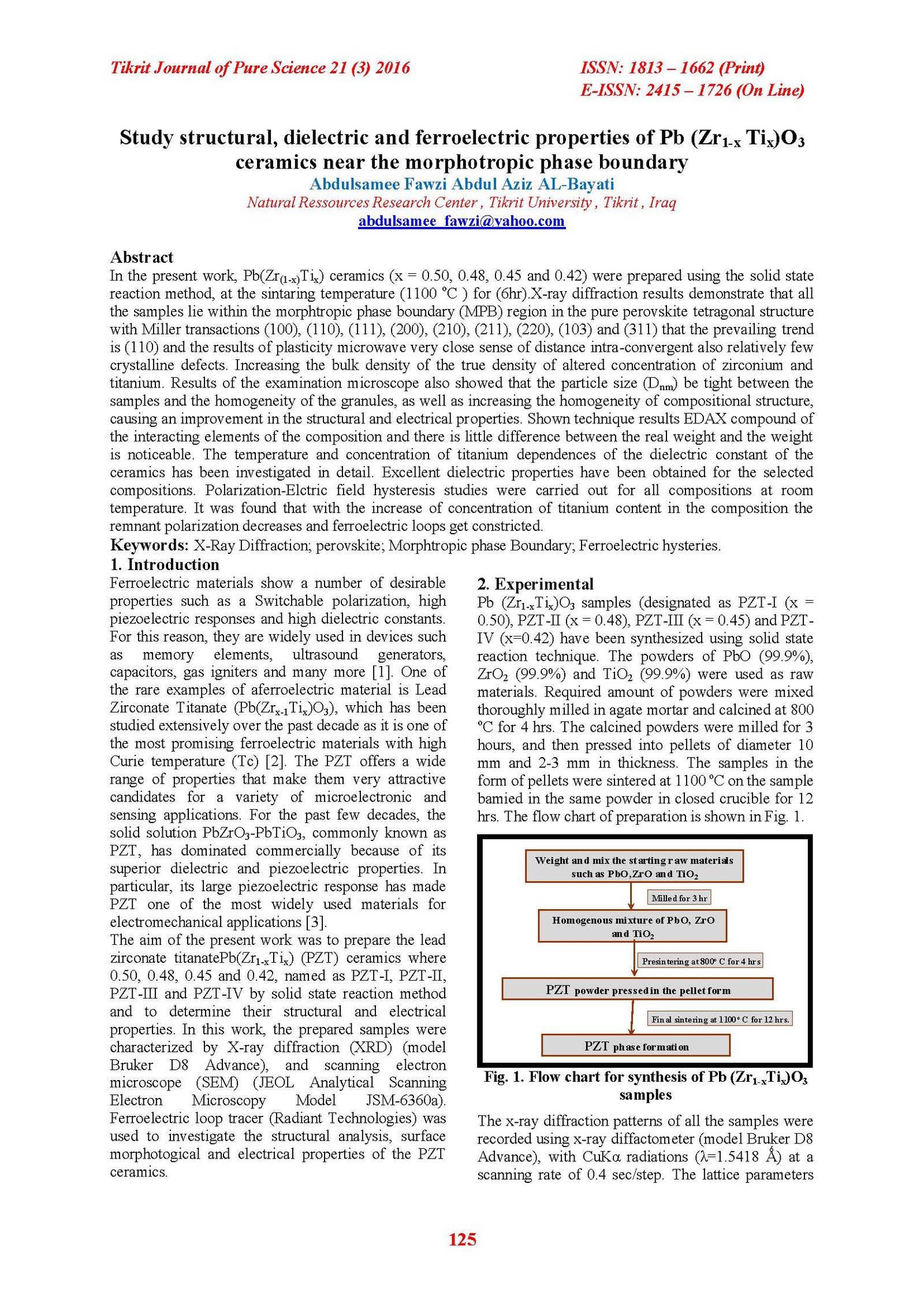Study structural, dielectric and ferroelectric properties of Pb (Zr1-x Tix)O3 ceramics near the morphotropic phase boundary
Main Article Content
Abstract
In the present work, Pb(Zr(1-x)Tix) ceramics (x = 0.50, 0.48, 0.45 and 0.42) were prepared using the solid state reaction method, at the sintaring temperature (1100 oC ) for (6hr).X-ray diffraction results demonstrate that all the samples lie within the morphtropic phase boundary (MPB) region in the pure perovskite tetragonal structure with Miller transactions (100), (110), (111), (200), (210), (211), (220), (103) and (311) that the prevailing trend is (110) and the results of plasticity microwave very close sense of distance intra-convergent also relatively few crystalline defects. Increasing the bulk density of the true density of altered concentration of zirconium and titanium. Results of the examination microscope also showed that the particle size (Dnm) be tight between the samples and the homogeneity of the granules, as well as increasing the homogeneity of compositional structure, causing an improvement in the structural and electrical properties. Shown technique results EDAX compound of the interacting elements of the composition and there is little difference between the real weight and the weight is noticeable. The temperature and concentration of titanium dependences of the dielectric constant of the ceramics has been investigated in detail. Excellent dielectric properties have been obtained for the selected compositions. Polarization-Elctric field hysteresis studies were carried out for all compositions at room temperature. It was found that with the increase of concentration of titanium content in the composition the remnant polarization decreases and ferroelectric loops get constricted.
Article Details

This work is licensed under a Creative Commons Attribution 4.0 International License.
Tikrit Journal of Pure Science is licensed under the Creative Commons Attribution 4.0 International License, which allows users to copy, create extracts, abstracts, and new works from the article, alter and revise the article, and make commercial use of the article (including reuse and/or resale of the article by commercial entities), provided the user gives appropriate credit (with a link to the formal publication through the relevant DOI), provides a link to the license, indicates if changes were made, and the licensor is not represented as endorsing the use made of the work. The authors hold the copyright for their published work on the Tikrit J. Pure Sci. website, while Tikrit J. Pure Sci. is responsible for appreciate citation of their work, which is released under CC-BY-4.0, enabling the unrestricted use, distribution, and reproduction of an article in any medium, provided that the original work is properly cited.
References
[1] Damjanovic D, Science of Hysteresis ,ed. G Bertotti and I. Mayergoyz, Elsevier, 76 (1987) 241.
[2] B. Praveenkumar, H.H. Kumar , D.K. Kharat, B.S. Murty Materials Chemistry and Physics 112 (2008) 31–34
[3] Sweta Sharma, Md Soaib Khan, Rajiv Ranjan, B. Behera, R.N.P. Choudhary Volume III, Issue IX, September 2014 Ijltemas 2278 – 254
[4] D.meyer hofer, Transition to the ferroelectric state in barium titanate, physical review.112 (2011) 58.
[5] S.O. Pillai “Solid State Physics”, New Age International Publishers Ltd., New Delhi (2002).
[6] C. Hammond," The Basic of Crystallography and Diffraction” Oxford University Press, Oxford (2001).
[7] C. Duran, S. T. McKinstry and G. L. Messing. J. Electroceram. 10 (2003) 47.
[8] A. M. Abdeen, O. M. Hemeda, E. E. Assem, M. M. El-Sehly., J. Magn. Magn. Mater. 238 (2002) 75.
[9] A. D. Sheikh and V. L. Mathe., J. Mater. Sci. 43 (2008) 2018.
[10] Xiwei Qi, Ji Zhou, Baorang Li, Yingchun Zhang, Zhenxing Yue, Zhilun Gui, and Longtu Li, J. Am. Ceram. Soc., 87 (2004) 1848.
[11] S. K. Kulkarni, "Nanotechnology: Principles and practices” (2007).
[12] L.S. Deshmukh, K. Krishnakumar, S. Balakrishna, A. Ramakrishna and G. Sasathaiah., Bull. Mater. Sci. 21 (1998) 219.
[13] Solymar and D. Walsh, "Lectures on the Electrical properties of Materials", Oxford University Press, Oxford (1984).
[14] T. Tunkasiri, Smart. Mater. Sci. 3 (1994) 243-247.
[15] S. A. Mazen, A. E. Abd El-Rahim, B. A. Sabrah, J. Mater. Sci. 22 (1987) 4177.
[16] K. K. Patankar, Ph. D. Thesis, Shivaji Univ., Kolhapur (2001)
[17] M. Prabu, Pb.D. Thesis, Pune Univ., Pune (2013).
[18] J. Paletto, G. Grange, R. Goutte and L. E.yraud, J. Phys. D: Apll. Phys. 7 (1974) 78-84.
[19] K. W. Wagner, Ann, Physik, 40 (1993) 818.
[20] C. G. Koops, Phys. Rev., 83 (1951) 121.
[21] P. Sarah and S. V. Suryanarayana, Indian J. Phys. 77 (2003) 449.
[22] Y.H. Tang, X.M. Chen, Y.J. Li, X.H. Zheng. Mater. Sci. Engg. B 116 (2005) 150.
[23] I. G. Austin and N. F. Mott Adv. Phys. 18 (1996) 411.
[24] Byung-Young Ahn and Nam-Kyoung Kim. J. Am. Ceram. Soc., 83 (2000) 1720-1726.
[25] V. L. Mathe, K. K. Patankar, U. V. Jadhav, A. N. Patil, S.D. Lotake, S.A. Patil, Ceramics, International. 27 (2001) 531.
[26] A. V. Dixit, Ph.D. Thesis, University of pune – pune- India (2003).
[27] A. R. James, B. S. Chandra Rao, S. V. Kamat, J. Subrahmanyam, K. Srinivas, O. P. Thakur., Smart. Mater. Struct. 17 (2008) 035020.
[28] M. S. Mohammed and R. Naik, J. Mater. Res. 11 (1996) 2588-2593.
[29] Q. M. Zhang and J. Zhao, IEEE Trans. Ultrason, Ferroelectr. Freq. Control. 46 (1999) 1518-1526.
[30] Pramod K Sharma, Z. Ounaies, V. V. Varadan and V. K. Varadan, Smart Mater. Struct. 10 (2001) 878-883.
